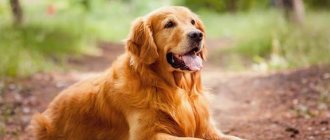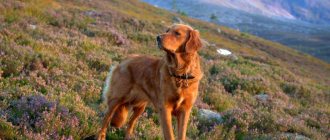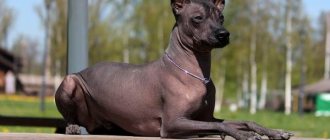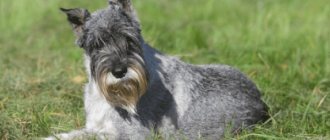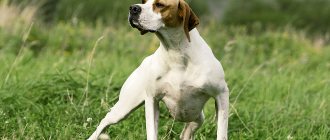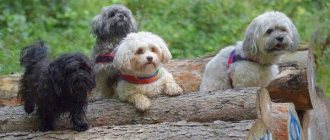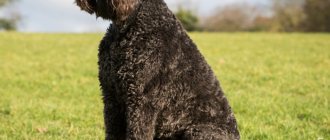The Nova Scotia Retriever is a hunting dog breed that is one of the rarest among retrievers. Bred in Canada, another name is toller. They are considered the smallest of their relatives, but their quality does not prevent the dog from remaining powerful, strong and agile. This is a fast and dexterous hunter, ready to please the owner.
The retriever is endowed with the qualities of a companion capable of becoming a full-fledged member of the family. These creatures absolutely love to communicate and play with people. They treat children adequately and get along well with them. Regarding the origin, a number of theories stand out. The Nova Scotia Retriever breed appeared recently in Nova Scotia, hence the name.
Toller history
It is not known exactly for what purpose the breed was bred, according to a probable version - for catching ducks. Indeed, Nova Scotia Retriever dogs are excellent hunters. Thanks to their excellent muscles, they quickly gain speed. It is believed that dogs were brought to the American continent from Europe, where dogs were famous for their ability to lure waterfowl.
The Irish Setter, English Spaniel, Golden Retriever, Sheltie and other European breeds of hunting dogs contributed to the origin of the breed. The result was wonderful: a small, fox-sized fire dog became a real duck dog, the pride of Yarmouth County, Nova Scotia (Canada). The breed turned out to be so popular and valued that once they even imposed restrictions on the export of dogs outside of Canada. The Canadian Kennel Club recognized the breed in 1945, and the Fédération Cynologique Internationale recognized the breed in 1995 (on its 50th anniversary).
Dogs appeared in Europe only in the late eighties. Thanks to their unique abilities they quickly became popular. Dogs are widespread in the Scandinavian countries.
The American Kennel Club recognized the breed relatively recently, in 2003, which did not prevent the dog from gaining popularity in the UK and Scandinavia. In Canada, the breed is extremely popular.
Hunting
Toller is described as an amazing dog with a special gift for attracting and presenting game birds. The four-legged creatures unobtrusively, as if playing, lures the bird into the line of fire. The bird literally stares at the playing Nova Scotia Retriever and loses its characteristic vigilance. The dog fools around until the coveted shot sounds, and then rushes into the water and brings prey to the hunter.
This is interesting! Nova Scotia Retrievers are called duck whisperers, decoy dogs, and fire dogs for their incredible ability to distract birds.
The character of the representatives of the breed can be called persistent or even punchy. The Nova Scotia Retriever is ready to work at any time, day or night, regardless of the weather or state of mind. Even in a doze, the four-legged animal instantly responds to commands or gestures associated with hunting or offering fetch. By the way, the need to offer something is of key importance in training and education. For Toller, treats are not as valuable as praise and the opportunity to bring fetch.
This is interesting! The Nova Scotia Retriever has very developed swimming skills, and in addition, the four-legged animals love water. When passing by a pond, the dog rushes to the shore without permission (since this desire is instinctive), this must be taken into account during walks and training.
General description and character
The Toller is an amazing dog that exhibits a unique ability to attract and present waterfowl. The pet playfully lures the ducks into shooting range, the ducks are attracted by the dog playing on the shoreline, the birds lose their vigilance. After a successful shot by the hunter, the tollers bring dead birds and wounded animals. That’s why they earned the name “fiery, luring dogs.” With a waterproof coat, Nova Scotia Retrievers are not afraid of even icy water.
The Duck Whisperer is a fun, playful companion with endless energy. At home the dog is bored, it seems melancholic, but when it finds itself in nature, it is completely transformed. The dog has a highly developed hunting instinct. Tollers are excellent swimmers, they adore water and are happy to get into it, ready to splash around around the clock.
A useful quality of a toller is considered to be a protective instinct. The dog is distrustful of strangers. For a long time he communicates with strangers coolly without familiarity. When the Nova Scotia retriever understands that there is no danger or threat, he will allow himself to be stroked behind the ears, and even to play.
Despite their gentle disposition, they are capable of showing aggression towards drunk people or strangers. This happens extremely rarely. In general, it is extremely difficult to unbalance an animal. Dogs have an excellent sense of smell and endurance. Despite the positive characteristics of the breed, the dog was recognized only in 2003.
The progenitor of the breed is also considered to be the Curly, or curly-haired retriever. A good-natured dog with developed hunting instincts. This breed, according to experts, has endowed the current Nova Scotia Retriever with an elongated muzzle and a wide chest.
Nova Scotia Retriever puppies are playful and capable of ruining anything that comes their way. Dog handlers claim that dogs exhibit a primitive level of intelligence; it will take a lot of time to explain mistakes and educate them. This dog can become noisy; when in a good mood, they love to bark for no reason. This is typical for a situation where a pet calls on members of the household to play together.
Living in an apartment requires proper upbringing. Paying attention to discipline and educational aspects is required from 5-6 months of age. The Nova Scotia Retriever dog breed needs constant attention from people. Loneliness causes deep melancholy in animals; pets follow their owner everywhere. It’s not scary to leave it in a room with a small child; the dog will never touch the baby. Children can pull the ears of a patient dog without expecting bared teeth in response.
How to choose a puppy?
Finding a good breeder of this breed is difficult because it is rare. On average, the cost varies between 55-90 thousand rubles.
When choosing a puppy, you need to pay attention to the main features that characterize the breed:
- developed neck and chest;
- straight back and graceful stance;
- active tail, wide at the base and narrow at the end;
- wedge-shaped skull with an elongated muzzle;
- medium-sized triangular ears;
- chocolate cream color with white spots;
- smooth, smooth gait.
From purchasing a puppy to having an obedient adult dog, you need to put a lot of effort into training. You need to be sure that you have the opportunity to devote the lion's share of your free time to raising a new family member.
Types and standard
Summary table of characteristics:
| Other name | toller |
| Lifespan | 10–14 years |
| Height | female: 45–48 cm, male: 48–51 cm |
| Weight | female: 17–20 kg, male: 20–23 kg |
| Wool | long, thick, water-repellent, straight |
| Color | copper, red gold, red |
| Character | intelligent, patient, vigilant, sympathetic, loving |
The description of the Nova Scotia Retriever breed begins with external characteristics:
- Height – 48-51 cm for males, 45-48 for females.
The height of the dog makes it an optimal option for keeping in an apartment. The dogs are cute and friendly. They behave carefully around children and are aware of their responsibility to their owners.
- Weight – 17-20 kg for females, 20-23 kg for males.
By the way, animals are capable of rapidly gaining weight and are prone to overeating. Potential dog owners should take note.
- The body is compact, muscular, the chest is deep.
A wide chest and powerful skeleton indicate excellent physical potential.
- Limbs are strong.
Doesn't boast high pushing power. Able to quickly gain speed and reach goals. Can jump high.
- Head – Shows a wedge-shaped and broad skull.
- The coat is waterproof, double, medium-length, and the dog has a soft, thick undercoat.
- Color - different shades of red or orange, white markings are welcome.
- The bite is scissor, a full set of teeth is required.
- The ears are triangular, medium in size, set high.
The dog is slightly fox-like in appearance and in its manner of attracting ducks. Demonstrates a cheerful, cheerful character. Characteristics:
- Country of origin – Canada;
- Life expectancy – 12-15 years;
- Group – 8 (Retrievers).
Lifespan
With proper care, life expectancy is 12-15 years. The breed was developed by crossing collies, shelties and some varieties of retrievers. On this basis, weaknesses were also inherited.
vitally important to vaccinate dogs, puppies are especially vulnerable to infections and should be isolated until fully vaccinated. The health of the offspring depends on the characteristics of the mother and her vaccination.
Duck hunters have inherited diseases from their relatives that can affect life expectancy:
- an eye abnormality inherited from a collie can lead to retinal detachment (vision loss);
- Addison's disease, which affects the functioning of the adrenal glands, which can be fatal;
- dermatomyositis is characterized by inflammation of tissues (skin and muscles);
- Enterocolitis (inflammation of the walls of the small intestine) is rare but can also be dangerous in this breed.
Disadvantages of the breed
With proper care, dogs rarely get sick, but duck retrievers exhibit hereditary diseases, you will need to carefully breed a unique breed of dog.
Juvenile Addison's disease, collie eye abnormality with progressive retinal atrophy, and hip dysplasia are common among dogs, making life difficult for pets and owners. Periodic veterinary examinations will help detect diseases at an early stage.
The dog is hyperactive and has an excellent appetite.
Black flat
The Flat-Coated Retriever (Flat) is a hunting dog. His pedigree is a mix of Labrador, spaniel and collie breeds. The Flat differs from its golden counterpart by its straight coat and black color. According to the International Canine Association, there is an approved standard and appearance that all breeders of this dog are guided by.
Dossier
Height of an adult: height of adult males at the withers - from 59 to 61 cm, females - from 57 to 59 cm. Weight: from 25 to 36 kg. Characteristic color: dark chocolate brown or black. Coat length: medium, straight with a characteristic silky sheen. Life expectancy: 10-14 years. Advantages of the breed: intelligent with high working qualities. An excellent companion dog. Difficulties of the breed: affectionate, sensitive, difficult to cope with separation or change of owner. Average price: 90-100 dollars. Classification: medium breed from the group of retrievers, spaniels and water dogs. Refers to hunting.
Theses
The breed was bred in the mid-19th century to solve specific hunting problems.
A distinctive feature of the breed is its color; dogs can be liver or black in color.
They perform well on the hunt and are valued by real hunters. But they are not very common as pets in the CIS countries.
Flats have a soft, good-natured, playful character.
They get along well with children, but they are quite large and can inadvertently knock a child down.
Like all hunting breeds, they are very energetic and tireless, long walks are necessary.
Purpose and hunting with a straight-coated retriever (flat)
The Flat-Coated Retriever is endowed with all the qualities and abilities of a gundog. Compared to Goldens or Labradors, he is faster, more maneuverable and resilient. As befits a retriever, he simply loves water and is a very professional swimmer and diver. Smart and attentive, he skillfully scares away a bird within a shot. In addition, his keen sense of smell and resourcefulness allow him to quickly find game on land and in water. Adapts quickly to changing circumstances and will work equally well with owner, trainer or guest.
The Flat-Coated Retriever is a tireless, passionate hunter, an unsurpassed fetcher and tracker who is always ready to work.
It is worth noting that in terms of hunting use, flats are more versatile than other retrievers. They easily learn to work by following the blood trail, try to be the first everywhere and always, but their main quality is complete solubility in the owner. Flat is multi-talented and can be an athlete or a service dog. The most suitable disciplines for obedience and agility: agility, obedience, flyball, dancing with dogs. In service dog breeding, the work of a search dog or a guide dog suits him.
Advantages and disadvantages
A versatile, intelligent working dog with many talents, stable, sociable, friendly to everyone at home. The straight-haired is considered the most active among other retrievers, agile, intelligent, with lightning-fast reactions.
These active, hard-working animals constantly need something to do. They are ready to hunt, search or play something constantly. The Flat-Coated Retriever remains a good-natured, gentle, cheerful dog until old age. They are usually very friendly, so using fletts as guards will not work.
According to reviews from owners of straight-coated retrievers, this breed has virtually no disadvantages. Character – easy to train, affectionate, loyal. The appearance is balanced - elegant and powerful at the same time. The only negative is that sometimes there are “too many” pets. A lively temperament constantly forces the dog to look for more and more new adventures.
Photos and price of puppies
The cost of a Nova Scotia retriever puppy reaches 60 thousand rubles.
How much does it cost and where can I buy it?
The cost of rare breed puppies is always high. In Russia, duck retriever dogs number only a few dozen specimens. You can find out about buying a pet at the nursery in St. Petersburg. The price of a Nova Scotia Retriever depends on the class of the puppy, starting from 45,000 rubles. Buying a pet for exhibition purposes will cost twice as much.
Many factors influence the cost:
- breed qualities of the parents;
- age and condition of the puppy;
- ancestor titles, pedigree;
- status of the nursery itself.
In the CIS countries and European countries, the cost of purebred puppies is in the same price range. Buying a baby Toller is a responsible and expensive undertaking. The owner must realize that a rare breed will show its best only in a home where the puppy is loved, raised, given time, and cared for.
Features of maintenance, care
The Toller is an amazingly smart and quick-witted dog that is easy to train. With proper training, it is considered the standard of canine obedience. But the dog is characterized by stubbornness; if you don’t take care of training in time, the toller will grow into an uncontrollable, headstrong dog. It is recommended to engage in the socialization of duck retrievers - allowing them to get used to other animals, preventing them from chasing cats on the street.
- Dogs get bored with monotony and monotony, get tired, and begin to mischief.
Tollers are not domestic or lap dogs; they have a highly developed hunting instinct; keeping a dog in a family without hunting enthusiasts is not worth it. Toller gets bored without wanting to, and becomes melancholic. It is acceptable to replace hunting with agility and flyball. Tollers achieve great success in games.
- Keeping them in an apartment is complicated by the abundance of hair that falls out, especially during the period of active molting, in autumn and winter. The coat should be combed and brushed regularly.
- The structure of the wool is silky and is little susceptible to contamination. Bathe the Toller as needed, but avoid using shampoos that disrupt the structure of the lubricant covering the coat.
- It is necessary to take care of your dog's claws; there is no need to cut off the claws - the growths grind off on their own without causing discomfort to the dog.
The dog needs communication with the owner, but if the person is busy, the dog can wait. Learns with ease, catches on the fly. Due to its small size, the toller will not be able to stop a large intruder, but it will try.
Keeping a Nova Scotia Retriever in chains is strictly unacceptable!
Toller gets along well with animals in the family, if any. The dog exhibits a tendency to dominate, having another dog with a similar tendency, for example, a shepherd, will cause difficulties. Tollers have excellent relationships with dogs that do not claim leadership. If the toller is not the only dog in the family, this is even better; the dog needs a partner for games and activities. Another dog will replace the person when he is busy.
Proper care of the Nova Scotia Retriever guarantees the absence of constant shedding and other unpleasant moments. There are no special nuances in care, you just need to pay attention to the following aspects:
- Cleaning wool. It is necessary to comb the dog with a special brush with rare teeth. Carry out the procedure at least once every three days. A retriever's coat is a source of pride and wealth; make an effort to make the coat look well-groomed and neat.
- Trim toenails no more than once every 5-6 weeks.
- Any four-legged pet is required to receive vaccinations. Animals are extremely inquisitive, especially during a walk. Capable of becoming infected from strangers when trying to meet them.
- Water treatments are a joy. It is acceptable to do it daily (without using shampoo). Detergents are used no more than once every one and a half to two months.
The main thing for a pet is to be in the company of its beloved family. A retriever will never show aggression unless absolutely necessary; the popularity of the breed continues to increase.
Pros and cons of the breed
Toller is a dog that has its pros and cons. This is a very smart and quick-witted breed. They are devoted to their owners and are always ready to actively protect them. Retrievers are excellent hunters and, thanks to their unique double coat, can withstand low temperatures.
The disadvantages of the breed include:
- Tollers absolutely cannot stand loneliness;
- severe shedding, requiring regular brushing;
- the need for long walks and physical activity.
Important ! You only need to walk your Canadian Retriever on a leash, as the pet gets carried away very quickly and can run away.
Retriever nutrition
It is better to feed tollers with natural food; it is acceptable to give dry food. The dog is not allergic. A balanced, fortified diet is encouraged. Excessive energy has earned him a reputation as a destroyer, but the duck retriever is no more destructive than any dog. With careful attention, the dog will stop destroying everything.
It’s easy to find out what to feed your Nova Scotia Retriever from your veterinarian or seller. This is not to say that the stomach or intestines are considered a weak point. Ready to eat whatever the owner offers. Let us denote a significant limitation regarding medium dogs:
You will need to exclude chicken meat and bones from your diet, which can cause indigestion. Tubular chicken bones scratch the walls of the stomach and intestines, especially in puppies.
Retrievers drink a lot, make sure there is fresh water in the bowl.
Until two months old, puppies eat only their mother's milk. Then porridge is gradually introduced into the diet, with the addition of meat. The amount of meat is increased gradually so that the puppy’s body gets used to it smoothly.
By the age of six months, the baby eats everything that the owners eat. The main thing is to control the portion size, dogs are prone to overeating.
Raising and training a pet
These dogs learn new information very easily and quickly. However, if you do not start raising a toller from a very early age, the puppy will grow into a stubborn and uncontrollable dog. You need to demonstrate to your furry baby who is boss on the first day of his arrival in the family. This pet needs a leader with leadership qualities.
When starting to train a dog, the owner must be prepared for the fact that it may show increased activity and restlessness. For this reason, it may take a lot of patience for the dog to begin to obey the owner’s commands. During classes, you cannot raise your voice, use physical force, or force your pet to perform certain actions. Studying should be built on respect, restraint, smooth and clear assignment of tasks, and encouragement.
In order to keep the dog's attention as much as possible, lessons should be short and intense. In addition, it is desirable that the educational process take place in a playful way.
It is recommended to start training a Toller when he reaches 5 months.
Historical reference
Tollers appeared in Scotland, hence their name - Nova Scotia Retriever . It was first mentioned in the XYII century. However, the route of its entry into Europe is not truly known.
Although many dog experts believe that this breed is the heir of the kooikerhondje, to which tollers are similar both visually and in behavior.
Kooikerhondje To a certain extent, shelties, cocker spaniels and Irish setters were involved in the development of the breed.
Despite the fact that Tollers have a European origin, the fundamental selection took place on the American mainland, where the breed was called the “Little River Duck Dog.”
By the mid-forties of the last century, the Toller was recognized in the Canadian dog breeding society, at the same time Nova Scotia retrievers returned to European territory and began to actively disperse in England and the Scandinavian countries. And in 1987, the initial breed standard was adopted.
Did you know? Dogs hate hugging - they perceive it as a sign of dominance.
What breed of dog was featured in the TV series “Five Minutes of Silence”
An action-packed film about the difficult everyday life of Russian rescuers aroused the sympathy of the domestic audience not only due to its exciting plot and excellent selection of talented actors. The script very successfully introduces a vivid image of a dog - a faithful friend of the rescuers, their invaluable and irreplaceable assistant. It is difficult to say what the dog’s peculiar nickname is connected with. Perhaps in his youth the puppy was quite well-fed.
Those who have already had the pleasure of watching the film will not forget the touching scenes in which Bubble helps pull a wounded person out of the rubble or saves a trainee rescuer drowning in a stormy river. In those moments when emergency workers have a temporary respite from emergency situations, the dog remains a true friend for them, with whom they can have a heart-to-heart talk, play and even play cards.
Color variations and appearance
Tollers are small in size, but have a powerful and muscular build.
- Dimensions. Males reach up to 51 cm in height and weigh on average 22 kg; females weigh 20 kg and grow up to 48 cm.
- Wool. The main feature of the duck breed is its thick double coat, thanks to which the dog can even jump into icy water. The downside is heavy shedding. Therefore, the retriever is not suitable for those who want a neat and clean dog.
- The color of the dog can take on various shades from brown to orange.
Mating
Dogs are ready for breeding only after 2 years . Despite early puberty (at 8-10 months), young animals will not be able to conceive and bear healthy offspring. The best time for mating is 13-15 days of the female’s 3rd estrus . During the year, the girl has a period of 2 times; the owner must record the start and end dates of the cycle.
2 weeks before the start, if mating is planned, contact the kennel club to find a partner. This way the puppies will receive official status and documents. Owners need to fill out contract documents and discuss the price.
At the appointed time, the pets are brought together in the dog’s territory or in a neutral place. The animals get to know each other, if the female is ready and the male smells it, he will try to mount. Tollers are proportional, so they do not require assistance. If difficulties in maintaining balance are noticeable, the owners should help the dogs stand up: hold the girl under the stomach, and hold the dog by the lower back.
Repeat mating after 2 days. After a week, the first signs of pregnancy will appear (changes in behavior, lack of appetite). But it is better to carry out tests at 2-3 weeks ; tests (urine, blood) or ultrasound are suitable.
Read a detailed article on the topic: “Everything you need to know about breeding dogs: appropriate age, what to do if it doesn’t work out, rules and tips.”
Physical activity: games and walks
Nova Scotia Retrievers are very hardy, but this trait needs to be handled wisely. If proper time is not given to walking, the dog will languish and torment the owner.
Since the Toller is an active dog, it will be very happy to follow its owner on walks or while jogging. However, do not forget that your pet must be kept on a leash.
Important! Each lesson should be short and as intense as possible. This is the only way to keep the retriever’s attention and give the required physical activity.
These dogs cannot always stick to the chosen direction and are easily distracted by people passing by.
Most of all, the Nova Scotia Retriever loves to frolic in the water: swimming, getting various objects. You can play flyball or agility with him.
Purpose
- Hunting. The full name of the dog, the Nova Scotia Retriever, is a duck lure, hence its original purpose - to help a person hunt ducks. The dog acted in the same way as the fox - its bright fur and fuss on the shore lured feathered game to itself. Another thing that distinguishes a retriever from a fox is that it is absolutely not afraid of water.
- Companion dog . Now he is just a cheerful friend and a faithful companion in fun and active games.
- Sport. The dog is very athletic and will definitely take prizes in various sports competitions.
Is it possible to keep in an apartment?
Due to their small size, tollers can live in an apartment. But it should be taken into account that this breed does not tolerate loneliness and needs regular long walks.
Most often, small and beautiful decorative dog breeds are often chosen for apartments. Therefore, it will be easier for you to keep in your apartment: a Yorkshire Terrier, Chihuahua, Pomeranian Spitz, Jack Russell Terrier, Pug, French Bulldog, Shih Tzu or Pekingese. Also find out which breeds are hypoallergenic.
In addition, the pet must have a permanent place. By the way, this breed loves to sleep on upholstered furniture.
Moreover, it is better that there are no foreign odors in the room where the toller lives. The best area for a Nova Scotia retriever is an enclosure near the house, and there should be a hunter in the family.
Description of the breed (requirements for the standard)
These are medium-sized dogs, but among retrievers the Toller is considered small in size, because the height of adult individuals is only about half a meter. A dog of this breed has strong bones; quite powerful, albeit compact, physique, not weak muscles. The ideal weight for males is 20 kg or slightly more. Female individuals may have a couple of kilograms less.
Dogs of this breed have a lot of advantages, but they are not suitable for all owners. They are smart, even to some extent intelligent, in addition, they are perky, playful, and resilient.
But these character traits impose a huge responsibility on the owner, who is obliged to bestow caring patience on the pet, paying due attention to its upbringing. A puppy should be taught various commands from the age of six months, with parental persistence.
According to the standard, all the characteristics that give purebred representatives are aimed at fulfilling their hunting functions. Tollers have a wedge-shaped head with a wide and strong rounded forehead, narrowed three times at the transition to the nose.
The muzzle is neat, not large in size, but of medium size, proportional, covered with thin, short, but thick hair that lies close to the base.
The nose with open wide nostrils is usually black, brown and even flesh-colored pigmentation is allowed. But at the same time, this shade in purebred dogs must be in harmony with the overall color, and the shape of the nose, according to the requirements, must emphasize the narrowing of the head.
The structure of the wide and developed jaws provides the animal with all the opportunities to capture prey, characterized by a not too protruding chin, as well as medium-thick lips that cannot be loose or saggy.
The teeth in the deep mouth are strong, healthy and well developed. But this is not enough to meet all the requirements, because tollers have a soft and careful grip, delivering wounded animals to the owner without inadvertently damaging valuable prey.
The ears of quadrupeds, which fit the head, are distinguished by their flexible elasticity, having the shape of a triangle, and are covered with dense, silky, short hair. The Toller dog has beautiful almond-shaped eyes, expressing joyful friendliness, captivating with an attentive and concentrated expression.
They are widely spaced, medium in size, brown, but not very dark. A heavy look is not allowed, the dog should not appear embittered even in the presence of strangers.
Dogs are sociable, but this quality manifests itself in them even through extremes; they do not want to tolerate loneliness and lack of attention. They are attractive for their friendliness and desire to flirt with adults and children, other animals: dogs, even cats.
They tease and fool around until they get attention in return. Dogs love to make a lot of noise by yapping loudly and a lot. Incredibly active Toller puppies, in the absence of their owners, are capable of creating a simply terrifying mess in the apartment, causing a commotion among the neighbors and destroying everything in their path.
However, four-legged pets behave perfectly and are quite happy with life if the owners take long daily walks with them, paying a lot of attention to the dogs. But it should be borne in mind that in a big city it is completely impossible to take them out without a leash; on walks, dogs are incredibly tireless, but at the same time excellent companions.
The animal's posture is proud, the neck is gracefully set, the body is rectangular in shape and proportional in build; the back is straight with muscular shoulders, the croup is quite powerful.
An interesting detail of the exterior is the tail, which demonstrates the mood and state of mind of the dog. At moments when the animal is calm and not excited by anything, being in a neutral mood, it is located just below the line of the back.
In moments of intense emotion, the tail rises slightly higher, but never rests on the croup. At the base, this detail of the external appearance is quite thick and wide, but closer to the end it becomes narrower.
A dog's legs are incredibly adapted for vigorous movement. They are straight and powerful, which helps to run quickly, but at the same time springy and flexible, in length corresponding to the proportions of these beautiful creatures. The paws end in arched fingers, equipped with powerful claws, so necessary for a hunting dog.
Special requirements are placed on the coat, which not only must be elastic and thick, but in purebred tollers it has a water-repellent undercoat, allowing the animal to enter cold, even icy water without health consequences, because dogs are waterfowl hunters, obliged to carry out their intended task. a wide variety of conditions, including adverse weather conditions.
The hair of a purebred dog is most often straight, in some cases slightly wavy. the Toller photo shows ) is rich, red, often with a reddish or soft beige tint.
Typically, representatives of the breed have at least one white marking on their coat, although this detail is not considered strictly necessary. But more often there are many more bright areas. They are located on the face and chest, often white areas stand out in the lower part of the paws, as well as on the tail.

